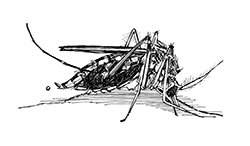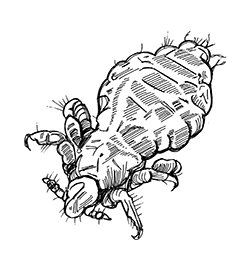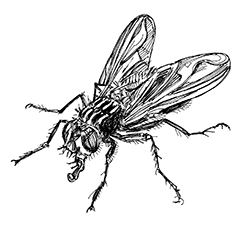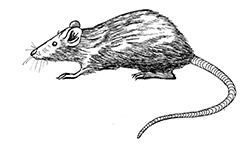Group 6. Zoonotic diseases spread by animals
 |
Disease tools: 20. Plague 21. Anthrax 22. Hantavirus pulmonary syndrome 23. Leptospirosis 24. Middle East respiratory syndrome or MERS coronavirus 25. Monkeypox 26. Rift Valley fever |
Zoonoses are infectious diseases of animals or rodents that can be transmitted to humans, causing severe illness or death. The animals in question may be affected by the disease themselves, or may remain (or appear to be) healthy; in either case, they can transmit the disease to humans. Part 1.4.4. of the manual discusses the importance of One Health. The One Health approach emphasizes that infectious diseases depend on many factors: human, animal and environmental. Animals can be infected by many germs, some of which may affect humans. People who are exposed to animals every day, because they farm or hunt or have pets, are at greater risk.
Scientists estimate that more than six in every ten known infectious diseases in people, and three in four new or emerging infectious diseases in people, are spread by animals. The zoonotic diseases that can cause epidemics include anthrax, leptospirosis, monkeypox, hantavirus pulmonary syndrome (HPS), Middle-East respiratory syndrome coronavirus (MERS-CoV), and Rift Valley fever (RVF); but many more are known, and many new diseases have probably not yet been discovered.
How are these diseases transmitted?
Zoonoses can be transmitted by touching the saliva, blood, urine, mucous, faeces, or other body fluids of an infected animal, as a result of petting or touching, or being bitten or scratched; or by touching areas where animals live and roam, or objects or surfaces that animals have contaminated with germs. Zoonoses may also be transmitted when people eat or drink unsafe animal products (such as unpasteurized milk, undercooked meat, or eggs), or raw fruits and vegetables that have been contaminated with faeces from an infected animal.
Some zoonoses can be transmitted by insects. (See the section on diseases transmitted by mosquitoes.)
Illustration 6. Insect vectors




Table 5. Disease transmission by animals
| Disease | Animals | Transmission |
|---|---|---|
| Rift Valley fever | Sheep, cattle, other animals. Signs and symptoms in infected animals: abortion; juvenile deaths. | Transmitted by mosquito bites, droplets in the air, the blood of sick animals, or the bodies of dead infected animals. |
| Avian influenza | Wild and domestic poultry (birds). Signs and symptoms in infected animals: Death or neurological signs; there may be no signs of illness. | Transmitted through droplets in the air, feathers, and potentially the eggs and meat of infected birds. |
| Monkeypox | Mainly monkeys. Also rats, squirrels and prairie dogs. Signs and symptoms in infected animals: in most cases none. Skin sores, breathing problems in prairie dogs | Transmitted by touching infected animals or their body fluids; the bites or scratches of an infected animal; the meat of an infected animal. |
| Plague | Mainly rats. Also rabbits, squirrels and prairie dogs. Signs and symptoms in infected animals: none in the above cases. The disease may cause cats and occasionally dogs to fall sick. | Transmitted by flea bites, droplets in the air, and the bodies of dead infected animals. |
| Leptospirosis | Cattle, pigs, rodents (mainly rats). Signs and symptoms in infected animals: abortion, liver and kidney disease. No symptoms in rats. | Transmitted by contact (with the eyes or mouth, through a cut, etc.) or ingestion of the urine of an infected animal. |
| MERS | Camels. Signs and symptoms in infected animals: none. | Transmitted by close contact with an infected animal or person. |
| Hantavirus pulmonary syndrome | Rodents (mainly rats). Signs and symptoms in infected animals: none. | Transmitted by droplets in the air of rodent urine or faeces; the bodies of dead infected rodents; bites or scratches. |
| Anthrax | Sheep, cattle (cows) and other animals. Signs and symptoms in infected animals: sudden death in sheep and cattle; neck swelling and breathing difficulties in pigs, dogs and cats. | Transmitted by spores in the air, and by contact with or eating infected animal products. |
What symptoms do they cause?
Zoonotic infections can be mild and even without any obvious symptoms. (This is very common in the case of leptospirosis.) Sometimes the symptoms are severe and the disease life-threatening. Anthrax can cause different forms of symptom (cutaneous [affecting the skin], intestinal, and respiratory). Leptospirosis can cause severe damage to the kidneys or liver. HPS and MERS-CoV usually cause coughing and shortness of breath. Monkeypox appears with fever and rash. Rift Valley fever is associated with a fever, headache, and joint and muscle pains.
How do we prevent the spread of these diseases?
Some zoonoses can be prevented by vaccinating animals (for example, for anthrax). Many infections will be prevented by hand hygiene and use of personal protection equipment (PPE) when in contact with animals and pets. In general, people should avoid contact with sick animals, and in particular should not eat sick animals.
It is important to cook animal products (meat, milk) thoroughly, to use only pasteurised milk when making dairy products, and to avoid eating unwashed vegetables and fruit.
How to deal with cases of these diseases?
Volunteers cannot treat patients who have a zoonosis disease, because they require specialized care from health professionals in a health centre. Volunteers can make a very useful contribution by identifying cases and referring them to health professionals.
How to detect an epidemic?
An epidemic of zoonosis is suspected in several circumstances. Zoonosis is sometimes detected in animals first, for example in the case of Rift Valley fever. An unusual number of sick or dying young animals and abortions can indicate an outbreak. In other instances, it is sometimes detected when many people are sick with an unusual illness, or when many people fall sick who have been in contact with animals or their products.
| The epidemic |
|---|
|
Who? Farm workers and hunters are commonly affected (fishermen uncommonly). It can also affect people who were not in direct contact with animals, but who inhaled their excreta or consumed animal products. Where? When? |
How to deal with an epidemic?
If a zoonosis epidemic occurs, you should do several things:
- Familiarize yourself with the culture of the community, especially hunting, farming and food production practices.
- Build trust with members of the community.
- Involve members of the community in efforts to control the epidemic.
- Take steps, in cooperation with the community, to detect sick people promptly and refer them swiftly to health facilities.
- Take steps, again in cooperation with the community, to detect sick animals.
- Improve hand and food hygiene.
- Restrict contact with animals. Use personal protection equipment (PPE).
What can volunteers do?
With this group of diseases, volunteers can contribute by promoting recommended health practices and by identifying cases and referring them to appropriate health facilities for proper care and treatment. You can:
- Make house-to-house visits to assess living conditions and identify sick people who have been in contact with animals, animal products or animal excreta.
- Report sick animals.
- Refer sick individuals to health centres or hospitals.
- Ensure that people have access to safe food and water.
- Give psychosocial support to sick people and their families.
- Assist animal health authorities with vaccination and elimination of sick animals under the supervision of technical experts.
- Mobilize members of the community and persuade them (using BCC) to adopt recommended health practices. In particular you should:
- Persuade people to wash their hands after dealing with animals and use personal protection equipment (PPE) (e.g. gloves, masks, shoes).
- Explain the symptoms of the animal-borne disease in question.
- Encourage people who are sick to go to a health facility.
- Advise people how to prepare safe food.
- Recommend that people should limit their contact with animals and with animal excreta.
- Strongly discourage people from eating sick or dead animals.
- Underline the importance of reporting sick animals.
Participate
Discuss in your group the possibility of a zoonotic disease epidemic in your community. Look at the disease tools for zoonotic infections and select the action and message tools for each disease. Discuss with your facilitator the similarities and differences between the tools for each disease in this category.
Discuss the important role of One Health in preventing epidemics.